Under the terms of the Montreal Protocol on protection of the ozone layer, regular assessments of the state of knowledge in this area are required by the signatory parties. The paper “Ozone depletion and climate change: impacts on UV radiation” by McKenzie and co-workers is part of one such assessment which was provided to the United Nations Environmental Panel (UNEP) through their Environmental Effects Assessment Panel (EEAP).
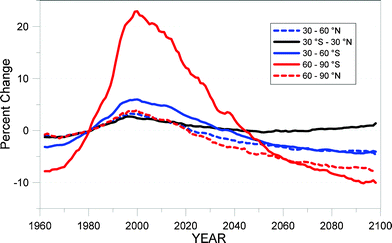
Change in the annual mean of noon-time clear-sky erythemally-weighted UV, 1960-2100, relative to the level in 1980.
The EEAP reports on the Environmental Impacts of Ozone Depletion and, in their more recent assessment, have been asked to comment on any interactions between ozone depletion and the climate change. In an attempt to make these assessments more accessible to the wider scientific community, they are also published in the peer reviewed scientific literature. Both the last two major assessments (2006 and 2010) and several interim reports of the EEAP have been published in Photochemical & Photobiological Sciences.
The paper by McKenzie et al. is essentially the first chapter of the most recent full assessment in 2010. That chapter assesses our progress towards understanding atmospheric research relevant to the effects of ozone depletion and climate change on solar UV radiation. It provides a link between (a) the more detailed and technical WMO/UNEP report on the Science of Ozone Depletion, and (b) the subsequent chapters of the EEAP assessment that report on the environmental effects on human health, the terrestrial environment, the aquatic environment, biogeochemical cycles, air quality, and material damage.

L. O. Björn, S. Madronich, R. L. McKenzie, A. F. Bais, P. J. Aucamp (M. Ilyas was absent, shown right). The photo was taken at the UNEP meeting in Zhengzhou China in August 2014 while working on the 2014 Assessment for which A. Bais will be the lead author.
These latter chapters are also published in the same special issue of Photochemical and Photobiological Sciences. Although not designed as a review, the chapter nevertheless provides a digestible short summary of important research results on the subjects of ozone depletion, UV radiation, and interactions between these issues and climate change that have appeared in the literature in the four years since the previous assessment.
Therefore, in addition to the primary purpose of providing an assessment for policymakers, the article also provides a useful introduction to the subject, especially for researchers new to the field and to educators. The scope is unique, as it provides a one-stop update of these diverse, yet interrelated issues. It is written in a style that makes it accessible to the general public without detailed knowledge of the issues.
As the topic is of wide interest to the scientific community, this 2011 article published in Photochemical and Photobiological Sciences is one of the most highly cited in the journal from recent years. The 2014 assessment is currently under review, and will be published in a special issue of Photochemical and Photobiological Sciences in early 2015.
Read the full paper to find out more:
Ozone depletion and climate change: impacts on UV radiation
R. L. McKenzie, P. J. Aucamp, A. F. Bais, L. O. Björn, M. Ilyas and S. Madronich
Photochem. Photobiol. Sci., 2011, 10, 182-198.











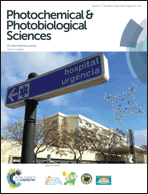 The front cover this month features work by Maria Faustino, Adelaide Almeida and co-workers from Aveiro, Portugal. In their work they set out to assess the efficiency of antimicrobial photodynamic inactivation (PDI) on clinical multidrug-resistant bacteria in hospital wastewaters, in order to evaluate its potential use in treating hospital effluents.
The front cover this month features work by Maria Faustino, Adelaide Almeida and co-workers from Aveiro, Portugal. In their work they set out to assess the efficiency of antimicrobial photodynamic inactivation (PDI) on clinical multidrug-resistant bacteria in hospital wastewaters, in order to evaluate its potential use in treating hospital effluents.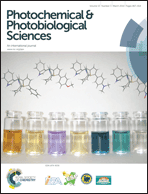 The front cover this month features work by Carlos Lodeiro and co-workers from Lisbon, Portugal. In their work report the synthesis of bis(indolyl)methane derivatives bearing functionalized arylthiophene spacers, and explore their solvatochromic behaviour in the ground and excited states.
The front cover this month features work by Carlos Lodeiro and co-workers from Lisbon, Portugal. In their work report the synthesis of bis(indolyl)methane derivatives bearing functionalized arylthiophene spacers, and explore their solvatochromic behaviour in the ground and excited states.
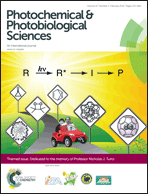 Dedicated to the memory of Nicholas J. Turro, late Professor of Chemistry at Columbia University, this issue presents a collection of articles from scientists either directly or indirectly associated with his laboratory. The collection reflects both the geographic diversity and breadth of scientific interests of those connected with Professor Turro .
Dedicated to the memory of Nicholas J. Turro, late Professor of Chemistry at Columbia University, this issue presents a collection of articles from scientists either directly or indirectly associated with his laboratory. The collection reflects both the geographic diversity and breadth of scientific interests of those connected with Professor Turro .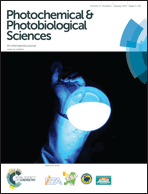
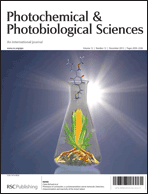
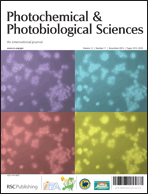 The front cover this month features work by M. Manikandan and Hui-Fen Wu from Kaohsiung, Taiwan. In their work they look at the differential photoresponse of acridine orange (AO) with live and dead cancer cells in fluorescence spectroscopy.
The front cover this month features work by M. Manikandan and Hui-Fen Wu from Kaohsiung, Taiwan. In their work they look at the differential photoresponse of acridine orange (AO) with live and dead cancer cells in fluorescence spectroscopy.